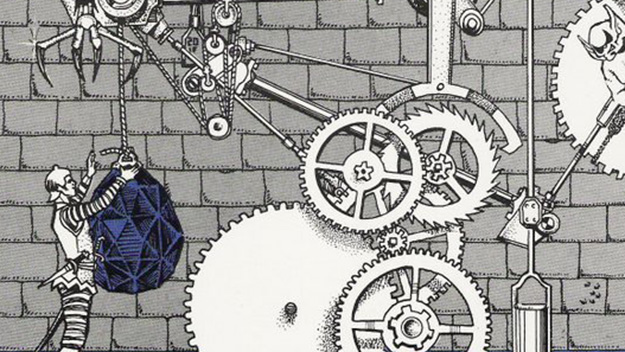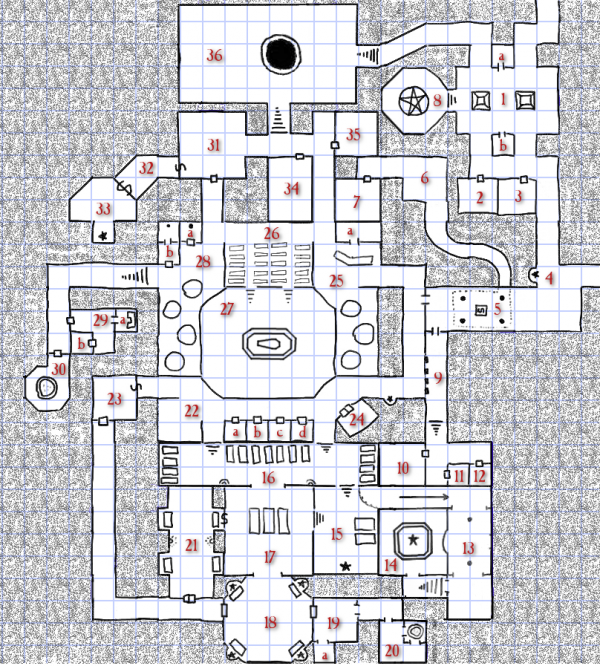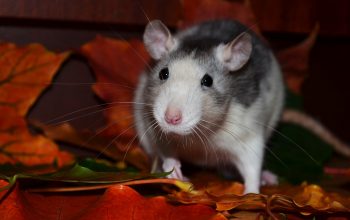
OK, it’s time at last to fill in the empty rooms. In the past I’ve always used the B/X tables for this, but I was inspired when writing this to at least look at the OD&D tables for a quick comparison. To start with, here are the B/X tables I’m used to:
First Roll: CONTENTS
Die Roll Results 1-2 Monster 3 Trap 4 Special 5-6 Empty Second Roll: TREASURE?
Die Roll Monster Trap Empty 1 Yes Yes Yes 2 Yes Yes No 3 Yes No No 4-6 No No No
So basically for each room we make two rolls, the first roll shows us the basic content of the room, and the second determines if there’s treasure there. This is actually almost exactly what OD&D tells us, but in that case we don’t get special entries for traps and specials:
Roll the die for every room or space not already allocated. A roll of a 1 or 2 indicates that there is some monster there.
…
Roll again for every room and space. A roll of 1-3 in those rooms or spaces with monsters in them indicates some form of treasure is present. A roll of 1 in a room or space which is unoccupied indicates that there is some form of treasure there.
Interestingly OD&D tells us to put “tricks and traps” into the dungeon and even gives a couple samples, it just doesn’t say anything about when or where to put them. B/X at least puts an entry on the chart, though its advice on inventing the stuff leaves a bit to be desired: “the DM should design his or her own traps and specials.” Great. Still, it has served me well so far, so I’m going to stick with the B/X tables.
For monsters, B/X tells me to roll on the wandering monster tables it supplies. In general I like these tables — they’re a d20 roll each and have a nice range of monsters. But, I’d like this dungeon to follow the theme established earlier so I chose to create my own table. Basically, I opened up my Monster Manual and wrote down every monster that sounded like it might fit. I gave no consideration to power level at all here. Partly that’s in line with Finch’s zen moment of “Forget Game Balance”, and partly it’s because I envision this as a reasonably high level dungeon (maybe for levels 6-8?), and I figure when a weaker monster comes up I will either juice up the numbers, or just give the players a break (and keep them on their toes, as an easy encounter can make experienced players a bit nervous.)
With a little effort I got my table count up to 20 – perfect. I did add two custom entries in there: “Acolyte of Yeenoghu”, which I’m thinking is a weaker version of the main villain and goes with the concept of a “sisterhood”, and “Spectral Jackal”, which I think is probably just a displacer beast with an Egyptian dog theme. So, here’s my table:
1. Acolyte of Yeenoghu
2. Spectral Jackal
3. Giant Beetle
4. Carrion Crawler
5. Giant Centipede
6. Gargoyle
7. Ghast
8. Ghoul
9. Clay Golem
10. Hell Hyena
11. Jackalwere
12. Mummy
13. Giant Scorpion
14. Skeleton
15. Giant Spitting Cobra
16. Spectre
17. Gynosphinx
18. Umberhulk
19. Wight
20. Wraith
OK, on with the show, let’s start rolling! As a reminder, here’s our map:
My process is simply to start at the first empty room and throw the dice. And of course right off the bat on the first room I got the hardest result: “special”. What exactly is a “special”? Well, it’s something weird for the players to figure out. It’s not exactly a trap, which I think of as something intentionally placed to harm intruders. A special is more like that famous room in B1 full of strange magical pools.
Well, room 1 is kind of weird looking with those two pillars or blocks and the inset little rooms marked ‘a’ and ‘b’. Nothing jumped out at me immediately, so I decided skip ahead a bit and see what’s in connected rooms 2 and 3. I figured maybe that will help inspire me as to what’s actually in room 1. The dice told me room 2 contains some spectres guarding a treasure, and room 3 is empty but also with treasure.
For some reason the parity of the two adjacent rooms made me think that maybe I should split the spectres up into the two rooms. Actually, as that idea percolated I started looking at room 1 again and inspiration struck. Let’s munge those rolls back up into room 1 as part of the ‘a’ and ‘b’ markers. Here’s what I came up with:
- Two large stone blocks covered in heiroglyphs which detail this as the crypt of King Tsekani. Those who wish to pay their respects should enter the north west passage, only priests may enter the south, and thieves will be put to immediate death. In ‘a’ and ‘b’ can be seen glowing scimitars suspended in the air. They are actually +2 weapons held by spectral gnolls, who will attack anyone attempting to seize the weapon or entering the southern passage.
Nice, a little treasure, and some weird writing for the players to try and translate. I was also thinking that maybe room 36 is some kind of pool for ritual cleansing before visiting the resting place of Tsekani. Though we’re not there yet, and it begs the question of what’s going on at 8. So I decided to jump right to 8 and find out what’s in there. The dice say: monster, giant scorpion, no treasure. OK:
8. Murals depict the life of King Tsekani. Center of room contains massive statue of a scorpion, which is in fact a petrified giant scorpion.
That’s a bit more like it in terms of how much text I like to have per room. The others have been wordy due to being special or having unique monsters. I’d like to see more rooms with just a line or two and plenty of room to improvise. For example, will something un-petrify the scorpion? Maybe — that’s a choice for the DM at the table.
Moving on I rolled for rooms 2 and 3, and both came up with the same result – empty and no treasure. That doesn’t mean that I don’t write anything for these rooms though. I put a little ambiance into each room, but nothing tricky for the players to figure out, no traps to hurt them, and no monsters to fight. So:
2, 3: Stone benches and hooks in the walls are all that remains in these rooms.
Perhaps the priests used those rooms for putting on ceremonial robes or some such before entering the priests halls to the south. Actually, between that and the guardians in room 1 I discovered I have accidentally created a little sub-theme for rooms 4, 5, and 9-12. In fact, I’m just going to grab the reigns here and fill in 4 without rolling any dice. When inspiration hits, why bother with random tables?
4. Clay golem standing in niche will attack anyone passing this point not in priests robes. Eastern corridor leads up to secret priest’s door near main entrance.
And so it goes. I’ll keep at it, and come back with another post if anything special or of particular interest concerning the process comes up. If not, there’ll be one final post to wrap things up and deliver the final product.



